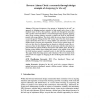Free Online Productivity Tools
i2Speak
i2Symbol
i2OCR
iTex2Img
iWeb2Print
iWeb2Shot
i2Type
iPdf2Split
iPdf2Merge
i2Bopomofo
i2Arabic
i2Style
i2Image
i2PDF
iLatex2Rtf
Sci2ools
DPPI
2007
ACM
2007
ACM
Reverse alarm clock: a research through design example of designing for the self
This paper documents a first attempt at "designing for the self", an approach to designing products intended to help people move closer to their idealized sense of self as they perform a specific role through the interaction with a product. This work follows a research through design approach, applying theory from consumer behavior research to address the needs of dual-income parents with young children. The clock, called the reverse alarm clock attempts to meet the goal of "Design for the Self" in four ways. First, the clock communicates information about time in a form children can understand, and so help children learn to become more responsible. Second, it gives parents more control over their lives by allowing them in absentia to relatively control the expression of time to their children. Third, the interaction with the clock has been placed within the intimate bedtime ritual parents and children share. Fourth, by keeping young children from waking their paren...
Clock Communicates Information | DPPI 2007 | Human Computer Interaction | Reverse Alarm Clock | Young Children |
| Added | 14 Aug 2010 |
| Updated | 14 Aug 2010 |
| Type | Conference |
| Year | 2007 |
| Where | DPPI |
| Authors | Kursat Kursat Ozenc, James P. Brommer, Bong-keum Jeong, Nina Shih, Karen Au, John Zimmerman |
Comments (0)

